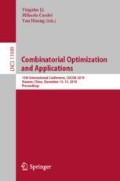Abstract
In this paper we consider special subclasses of directed co-graphs and their characterizations. The class of directed co-graphs has been well-studied by now and there are different definitions and applications. But whereas for undirected co-graphs multiple subclasses have been considered and characterized successfully by several definitions, for directed co-graphs very few known subclasses exist by now. Known classes are oriented co-graphs which we obtain omitting the series composition and which have been analyzed by Lawler in the 1970s and their restriction to linear expressions, recently studied by Boeckner. We consider directed and oriented versions of threshold graphs, simple co-graphs, co-simple co-graphs, trivially perfect graphs, co-trivially perfect graphs, weakly quasi threshold graphs and co-weakly quasi threshold graphs. For all these classes we provide characterizations by finite sets of minimal forbidden induced subdigraphs, which lead to first polynomial time recognition algorithms for the corresponding graph classes. Further, we analyze relations between these graph classes.
Access this chapter
Tax calculation will be finalised at checkout
Purchases are for personal use only
Notes
- 1.
We use the same symbols for the disjoint union and join between undirected and directed graphs. We want to emphasize that the meaning becomes clear from the context.
- 2.
The proofs of the results marked with a \(\bigstar \) are omitted due to space restrictions, see [15].
- 3.
Note that \(Q_1=D_{11}\) and \(Q_2 = D_{15}\).
- 4.
\(D_{12}\) is equal to \(\text {co-}Q_2\).
References
Bang-Jensen, J., Gutin, G. (eds.): Classes of Directed Graphs. Springer, Cham (2018). https://doi.org/10.1007/978-3-319-71840-8
Bang-Jensen, J., Maddaloni, A.: Arc-disjoint paths in decomposable digraphs. J. Graph Theory 77, 89–110 (2014)
Bapat, R., Lal, A., Pati, S.: Laplacian spectrum of weakly quasi-threshold graphs. Graphs Comb. 24(4), 273–290 (2008)
Bechet, D., de Groote, P., Retoré, C.: A complete axiomatisation for the inclusion of series-parallel partial orders. In: Comon, H. (ed.) RTA 1997. LNCS, vol. 1232, pp. 230–240. Springer, Heidelberg (1997). https://doi.org/10.1007/3-540-62950-5_74
Bodlaender, H., Möhring, R.: The pathwidth and treewidth of cographs. SIAM J. Disc. Math. 6(2), 181–188 (1993)
Boeckner, D.: Oriented threshold graphs. Australas. J. Comb. 71(1), 43–53 (2018)
Chvátal, V., Hammer, P.: Aggregation of inequalities in integer programming. Ann. Discrete Math. 1, 145–162 (1977)
Corneil, D., Lerchs, H., Stewart-Burlingham, L.: Complement reducible graphs. Discrete Appl. Math. 3, 163–174 (1981)
Corneil, D., Perl, Y., Stewart, L.: Cographs: recognition, applications, and algorithms. In: Proceedings of 15th Southeastern Conference on Combinatorics, Graph Theory, and Computing (1984)
Courcelle, B., Olariu, S.: Upper bounds to the clique width of graphs. Discrete Appl. Math. 101, 77–114 (2000)
Crespelle, C., Paul, C.: Fully dynamic recognition algorithm and certificate for directed cographs. Discrete Appl. Math. 154(12), 1722–1741 (2006)
Golumbic, M.: Trivially perfect graphs. Discrete Math. 24, 105–107 (1978)
Gurski, F.: Dynamic programming algorithms on directed cographs. Stat. Optim. Inf. Comput. 5, 35–44 (2017)
Gurski, F., Komander, D., Rehs, C.: Computing digraph width measures on directed co-graphs. In: Gąsieniec, L.A., Jansson, J., Levcopoulos, C. (eds.) FCT 2019. LNCS, vol. 11651, pp. 292–305. Springer, Cham (2019). https://doi.org/10.1007/978-3-030-25027-0_20
Gurski, F., Komander, D., Rehs, C.: On characterizations for subclasses of directed co-graphs. ACM Computing Research Repository (CoRR) abs/1907.00801, 25 pages (2019)
Gurski, F., Komander, D., Rehs, C.: Oriented coloring on recursively defined digraphs. Algorithms 12(4), 87 (2019)
Gurski, F., Rehs, C.: Directed path-width and directed tree-width of directed co-graphs. In: Wang, L., Zhu, D. (eds.) COCOON 2018. LNCS, vol. 10976, pp. 255–267. Springer, Cham (2018). https://doi.org/10.1007/978-3-319-94776-1_22
Gurski, F., Rehs, C.: Comparing linear width parameters for directed graphs. Theory Comput. Syst. 63(6), 1358–1387 (2019)
Gurski, F., Rehs, C., Rethmann, J.: Characterizations and directed path-width of sequence digraphs. ACM Computing Research Repository (CoRR) abs/1811.02259, 31 pages (2018)
Gurski, F., Wanke, E., Yilmaz, E.: Directed NLC-width. Theor. Comput. Sci. 616, 1–17 (2016)
Heggernes, P., Meister, D., Papadopoulos, C.: Graphs of linear clique-width at most 3. Theor. Comput. Sci. 412(39), 5466–5486 (2011)
Kitaev, S., Lozin, V.: Words and Graphs. Springer, Cham (2015). https://doi.org/10.1007/978-3-319-25859-1
Lawler, E.: Graphical algorithms and their complexity. Math. Centre Tracts 81, 3–32 (1976)
Lerchs, H.: On cliques and kernels. Technical report, Department of Computer Science, University of Toronto (1971)
Nikolopoulos, S., Papadopoulos, C.: A simple linear-time recognition algorithm for weakly quasi-threshold graphs. Graphs Comb. 27(4), 557–565 (2011)
Sumner, P.: Dacey graphs. J. Aust. Soc. 18, 492–502 (1974)
Wanke, E.: \(k\)-NLC graphs and polynomial algorithms. Discrete Appl. Math. 54, 251–266 (1994)
Acknowledgments
This work was funded by the Deutsche Forschungsgemeinschaft (DFG, German Research Foundation) – 388221852.
Author information
Authors and Affiliations
Corresponding author
Editor information
Editors and Affiliations
Rights and permissions
Copyright information
© 2019 Springer Nature Switzerland AG
About this paper
Cite this paper
Gurski, F., Komander, D., Rehs, C. (2019). Characterizations for Special Directed Co-graphs. In: Li, Y., Cardei, M., Huang, Y. (eds) Combinatorial Optimization and Applications. COCOA 2019. Lecture Notes in Computer Science(), vol 11949. Springer, Cham. https://doi.org/10.1007/978-3-030-36412-0_20
Download citation
DOI: https://doi.org/10.1007/978-3-030-36412-0_20
Published:
Publisher Name: Springer, Cham
Print ISBN: 978-3-030-36411-3
Online ISBN: 978-3-030-36412-0
eBook Packages: Computer ScienceComputer Science (R0)

